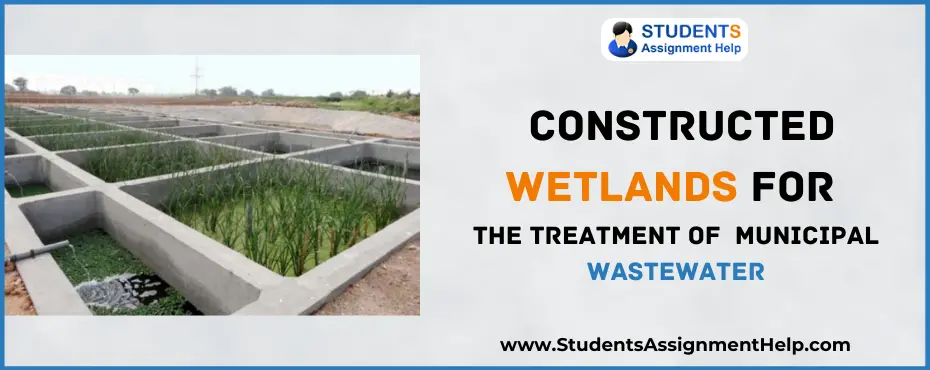Review the Effectiveness of Constructed Wetlands for the Treatment of either Municipal Wastewater

Introduction/Background
The topic selected for this review paper is related to wastewater treatment with the implication an effective technique. For such purpose, the technique or methodology selected for review purpose is constructed wetland and its effectiveness in the treatment of municipal water. A constructed wetland is also called a wetpark which is created artificially as a restored habitat for anthropogenic discharge including sewage water, waste water storm water, etc.
The constructed wetlands are different from natural wetlands as natural wetlands work in the form of biofilters which acts for the removal of pollutants and sediments and other contaminated wastes from the water, while constructed wetlands in their designing do emulation of these features (United States Environmental Protection Agency, 2000). Under the topic selected for review purpose, the prime focus is given on the removal of pathogens from the municipal wastewater in order to make it purify and usable.
Flexible Rates Compatible With Everyone’s Budget
Hire a Professional Essay & Assignment Writer for completing your Academic Assessments
As per the background information of this review work, it is focused that the main purpose of constructing wetlands is the treatment of the wastewater in any form. For cleansing and reoxygenation the water, in the designing of constructed wetlands, selection of plants and substrates is done in such as way that a right biological environment can be developed for the treatment of the water. The modeling of the wetlands is done on natural wetland systems, and these wetlands are designed for achieving efficiencies in the water treatment at optimum level. For wastewater treatment, constructed wetlands provide very cost effective alternate technology (Rybczyk, Callaway and Day, 1998).
The development of the wetlands is done specifically with improved engineering in order to improve the quality of water treatment process. The prime purpose of constructed wetlands is to work as ConstructedWetland Treatment System (CWTS). These systems were earlier constructed and used for the treatment of loaded wastewater of low volumes to degrade the organic material mixed in it in the urban areas (United States Environmental Protection Agency, 2000). Later on, with the increase in the demand of the improved water quality, and reclamation of water, the implementation of CWTS became an essentiality all over the world. The two main classes of constructed wetlands are horizontal flow system (HFS) and vertical flow system (VFS) (Kröpfelova, 2008).
The waste water treatment and its management is the major concern in the environmental management process and this is the context, the application of constructed wetlands for treatment of municipal wastewater is quite closer to environmental management practices. This is because the wastes from different sources discharge into the surface water and thus causes several environmental problems and consequences to human health. In order to deal with such water related environmental problems, several new technologies were invented for the effective treatment of waste water to make it fit for drinking purpose (United States Environmental Protection Agency, 2000).
Among such technologies, constructed wetlands have been proved very much effective and significant to maintain the physical, chemical and biological integrity of the water through making it free from different loads such as sediments, pathogens, etc and making it usable for drinking purpose. In this way, this subject topic of review has greater concern and relevance with environment management.
Performance Effectiveness in Contaminant Removal-
Wetland can be regarded as one of the major technological advancement in the field of environment protection. Exploring the importance and significance of Wetland technique in removal of contaminants such as Pathogens in the municipal waste water, Arias at al (2003) have stated that like other biological waste water treatment techniques, constructed wetland technique also provide variable results in removal of critical pathogens from municipal water. For instance, the authors have provided results of some crucial studies done on North American constructed wetland systems. As per the results of this study, this system leads to remove 50-90% of organic compound, 40-94% of pathogens, and 30–98%, nitrogen from the municipal waste water. In this way, the researcher has provided some positive findings regarding significance of wetland water treatment technique for removing pathogens from water.
Werker, Dougherty, McHenry, and Van Loon (2002) have also explored the removal of pathogens from water with the help of wetland technique. In the views of the authors, contamination of pathogens in water can be reduced by enhancing level of oxygen and other nutrients in water. Wetland measure can be proved quite effective and crucial in this regard. Wetland techniques lead to improve the quality of water with the help of different natural process, such as improvement in wetland vegetation, soil and microorganism development that can be able to control pathogens. In addition to this, wetland technique also induced to use chronic anthropogenic nutrient, which can degrade the pathogens and improve the overall quality of water.
Wetland region leads to include various crucial measures for the removal of pathogens from water. In this context, Coleman (2000) has specified different measures such physical pathogen removal measures, Chemical pathogen removal process, and biological pathogen removal process so that any critical contamination from water can be removed. In the physical removal processes, various forms of filtration are used for the purpose of removing and filtering pathogens.
In addition to chemical removal process, UV irradiation and oxidation processes are taken into account for controlling pathogens from water. Along with this, the author has also reflected biological pathogen removal process used in Wetland system. As per the author in the wetland region, different process such as bio film adsorption, predation by biomes such as Protozoa and release of different types of antibiotics with the help of plants and other microorganism, are followed for the purpose of controlling density and intensity of different pathogens.
Along with this, the type of wetland vegetation can also be proved quite effective the process related to the removal of pathogen. In the views of Karathanasis, Potter and Coyne (2003) there are several plant species which do not contribute directly in pathogen removal, while there are some other plant species found in wetland which play a significant role in reduction of pathogens.
For instance, the author has indicted that plant species such as Hydrophytes do not provide direct contribution in pathogen removal, while other species such as Phragmites and Typha shows high pathogen reduction rate, which leads to make municipal water free from contamination. As per the research conducted by the researchers, specified that plant species such as Phragmites and Typha release high rate of oxygen in the environment that makes the water clean and non polluted. The highs degree of usage of such types of vegetation undertaken primarily in wetland system makes wetland technique as an effective and crucial technique for removing pathogens effectively from water.
Extending the span of discussion over topic further, Karima et al (2004) have also presented their research regarding wetland technique and its utility in wastewater treatment. As per the findings of the researchers, in the field of constructed wetlands, Microorganism found in wetlands play significant role in the process of mineralization and transformation process of enhancing the presence of nutrients and decrease the impact of organic pollutant in water.
In the wetland system, pathogenic contaminants in water are metabolized are undertaken in different ways, which directly depends upon the helophyte’s input of oxygen in water, as well as, availability of other crucial electronic acceptors. For instance, at wetland, subsurface flow system is followed in which aerobic processes near the root of the plants are taken into account which leads to enhance the intensity of oxygen released from plant.
In the views of Merlin, Pajean and Lissolo (2002) in comparison to other methods of waste water treatment, wetland method of wastewater treatment can be proved quite effective and professional. As per the views of the authors, in the case where septic tank-soil drain field systems become necessary, the performance efficiency of constructed wetland leads to enhance up to a significant level as this method is quite enable to provide low cost and easily managed system.
The level of performance of such crucial system can be revealed by the capabilities of the system to provide effective solution to residential solutions of problems related to contamination of water. In this way, different academic assumptions are stating that wetland systems can be proved quite effective and crucial for the purpose of making water free from harmful contamination from waste water treatment. There are several crucial examples in which, the role of wetland in removal of wetland can be taken into account.
For example, the wetland system has been proved quite successful and effective colder climatic conditions. Wetland system in have been proved quite successful in the conditions of Canada, Scandinavia, Northern United states and European region. The example of Constructed Wetlands for Perdido Municipal Landfill Leachate, Florida (US) can also be considered as the prime example of the effective performance of Wetland system. In this case, the constructed landfill project have been proved quite effective in reducing different types of contaminants, such as Organic carbon, Iron, phosphorus, harmful pathogens.
After implementing this project, the level of such contaminations was decreased up to 96%. In addition to this, other contaminants such as suspended solids, irons and nitrogen levels in municipal water have also been decreased by 98%. This project undertaken in the case of Perdido Municipal Landfill Leachate has shown successful low cost method for the purpose of making water free from pollutants (Lorion, 2011).
In the same manner, this case can also be analysed critically in the case of Constructed Wetlands at Apache Powder Superfund Site, Arizona. At this site, the prime issue was related to the high level of nitrogen related product, and other critical pathogens in municipal water. At this site, multi-celled wetland system has been implemented for the purpose of treating excess nitrates and pathogens in municipal (Lorion, 2011).
In this method, groundwater was shallow aquifer and wetland cell is piped in the most effective manner. In context to this, this project was proved quite successful in reducing the level of nitrate from water as nitrate level was reached to 10 ppm at the site. The presented case study has reflected that overall role of wetland technique can be considered quite effective and less cost occurring (Okurut, 2000).
In this way, on the basis of overall review of different crucial literatures and case study examples on basis of which it can be reflected that wetland system for environment safety and waste water treatment can be proved effective and crucial. Different examples have stated that this system performs quite effectively in making water free from pollutants and contaminated.
Strengths and Weaknesses
Wastewater has become a critical environmental issue in the current world which has been having growing public awareness. In order to protect environment, the governmental legislations have been increasing promptly. The demand of the standards of wastewater and stringent water treatment is increasing rapidly. This has been evident that in the present world, due to restrictive economic climate and capital resources, in the present world, there is a limit on the conventional wastewater treatment infrastructures facilities (Werker, et al, 2002).
In the present world, the alternative treatments of the wastewater technologies are stimulated in the recent years. The plant based unit processes are considered more sustainable solutions for recycling of the wastewater and wastewater treatment. The current practices of wastewater management through constructed wetlands are heuristic in nature. In the design and methodology of the constructed wetlands there has been experienced a significant level of change in the recent years (Hencha et al 2003).
There are several positive sides of the technology of constructed wetlands due to its wider implications. The first major strength of the wetlands is that is a relatively inexpensive technique for installation. Its running cost ranges from zero running cost and even electricity requirements and there is no requirement of using pumps.
The gravity requires at ideal level to keep the effluent down for a constructed wetland. The other advantage of the constructed wetlands that makes this system over the other technologies is that constructed wetland is its adaptability (FH Wetland Systems Ltd, 2014). The function of wetalnds is very effective that have waste load in variable manner. The constructed wetlands can be fitted in existing or overloaded systems.
This shows that adequate treatment of the wastewater discharge is not possible in the cases of villages and small towns because in these areas, there are large safety tanks already. In order to keep the maintenance cost and inputs minimum, the use of chemicals is not required to operate them. On the other hand, in the cases of discharge of low phosphate, the constructed wetlands are considered the best technique to capture pathogens and other additives from the effluent which come from different settling systems and conventional dosing (FH Wetland Systems Ltd, 2014). The other major strength of constructed wetlands is that they prove very much attractive as visiting sites and even they provide hosting place for different kinds of birds and other fauna throughout the year.
In short, there are several advantages of constructed wetlands which are proved their strengths. The main strengths which are reflected as a whole are high treatment efficiency, minimum requirement of maintenance, low requirement of energy, low cost of running, tolerant of variable loads, no requirements of using chemicals, highly beneficial for wildlife, aesthetically pleasing, etc (Ghermandi, Bixio, and Thoeye, 2007).
The strength of the constructed wetlands can be evident through the example of case study. This case study reflect is related to issue of growing water stress in Europe which created deterioration of water quality as well as scarcity of water due to which the municipalities were prompted for adopting an efficient use of water resources through implication of water reuse practice.
There are wider ranges of technology options available for such purpose, yet constructed wetlands proved as the key elements in polishing wastewater which are conventionally treated and even has proved supportive to make the water free from pathogens. It has been even proved to make the water surface free from all impurities as per a survey (Ghermandi, Bixio, and Thoeye, 2007). The survey reflects that the performance of the constructed wetlands has been proved effective for the treatment of key and emerging categories of contaminants and even has made the water reusable.
One more example of the case study of use of constructed wetlands for wastewater treatment is evident in Malysia. In Malaysia, constructed wetlands have been developed for the treatment of wastewater. The example of use of constructed wetlands system is in Putrajava (Sim, 2003). This has been proved a very impressive system for the treatment of the municipal wastewater that through enhancement of the water quality as well as the visual landscape of the city (Sim, 2003). The Nature Interpretation Centre has also raised awareness among public to increase the value of these constructed wetlands in the sight of the general population.
Other than, these strong points, even there are several weaknesses of the constructed wetlands. The major weakness of the constructed wetlands is requirement of high land area, preliminary treatment requirements, requirement of high retention time, and problems caused to pests. Other than this, the nutrients of the water are also lost due to flow of nutrient rich water into water bodies (Hammer, 1989).
In the surface runoff, the constructed wetlands results into reduction of nutrient concentration and pesticides and thus water quality degradation is major disadvantage of this technique. The integration of these systems is required to be integrated with the management plans for conservation of water. The high cost of installation of these systems is the major disadvantage as for making them gravel and other fills are required (Hammer, 1989).
Conclusion/Recommendations 500
On the basis of the analysis of the entire discussion made in the paper, it can be reflected that Wetland system can be considered quite crucial and effective in order to make the waste water free from different critical contaminants. In regard to this, the presented discussion is directed to focus upon treatment of pathogen contaminated municipal water with the help of wetland system. The paper has reflected several case study examples through which, it can be cleared that for a community, the wetland system can be regarded as one of the major and effective systems which can control the overall level of pollution and pathogens in water effectively.
Recommendation:-
For the purpose of making the implications of constructed wetland system more effective and success in environmental protection regimes, some crucial and workable recommendations can be given to the administrative and managerial bodies of the project. Some of the crucial recommendations can be listed as below:
Choice of wetland plant species:- For the purpose of having effective and desired results of the constructed wetland, it is essential for the management of the project to have rational choice of different plan species. In this regard, there are different plan species which do not contribute in pathogen removal, while there are several species which plays intensive roles in removal of pathogens in municipal waste water (Rybczyk, Day, and Conner, 2002). Owing to this reason, there is a need of having rational choice of plant species.
Area of reed bed:- For the purpose of reducing the level of short-circuiting problem and other critical operational faults, constructed wetland projects are recommended to build maximum effective treatment zone, which can lead to make the areas more efficient (The use of constructed wetlands for wastewater treatment, 2003).
Monitoring and regular maintenance of the wetland areas:- There is a need of having regular and effective monitoring and project evaluation in which the performance level of the constructed wetland can be revealed. Proper monitoring of the project will allow the project owners to control overall costs related to the project and enhance overall efficiency of the project (Park, N., et al, 2009).
References
Coleman, J., Hench, K., Garbutt, K. Sexstone, T., Bissonnette, G. and Skousen, J. 2000. Treatment of domesticwastewater by three plant Species in constructed wetlands. Water, Air, and Soil Pollution 128, pp 283–295.
FH Wetland Systems Ltd. 2014. Natural Solutions for Waste and Wastewater. [Online]. Available at: https://www.wetlandsystems.ie/constructedwetland.html [Accessed on: 13 October 2014].
Ghermandi, A., Bixio, C., and Thoeye, C. 2007. The role of free water surface constructed wetlands as polishing step in municipal wastewater reclamation and reuse. Science of The Total Environment 380(1-3), pp. 247-258.
Hammer, D.A. 1989. Constructed Wetlands for Wastewater Treatment: Municipal, Industrial and Agriculture. Florida: CRC Press. Arias, C.A., Cabello, A., Brix, H. and Johansen, N.H. 2003. Removal of indicator bacteria from municipal wastewater in an experimental two-stage vertical flow constructed wetland system. Water Science and Technology 48 (5), pp 35–41.
Hencha, K.R. Bissonnettea, G.K. Sexstonea, A.J., Colemanb, J.G., Garbuttb, K. and Skousena, J.G. 2003. Fate of physical, chemical, and microbial contaminants in domestic wastewater following treatment by small constructed wetlands. Water Research 37, pp 921–927.
Karathanasis, A.D. , Potter, C.L. and Coyne, M.S. 2003. Vegetation effects on fecal bacteria, BOD, and suspended solid removal in constructed wetlands treating domestic wastewater. Ecological Engineering 20, pp 157-169.
Karima, M.R., Manshadia, F.D., Karpiscak, M.M. and Gerbaa, C.P. 2004. The persistence and removal of enteric pathogens in constructed wetlands. Water Research 38, pp 1831–1837
Kröpfelova, L. 2008. Wastewater Treatment in Constructed Wetlands with Horizontal Sub-Surface Flow. Springer Science & Business Media.
Lorion, R. 2011. Constructed Wetlands: Passive Systems for Wastewater Treatment. [Online]. Available at: https://epa.gov/tio/download/remed/constructed_wetlands.pdf [Accessed on: 13th October 2014].
Merlin, G., Pajean, J. and Lissolo, T. 2002. Performances of constructed wetlands for municipal wastewater treatment in rural mountainous area. Hydrobiologia, 469, pp 87–98.
Okurut, T.O. 2000. A Pilot Study on Municipal Wastewater Treatment Using a Constructed Wetland in Uganda IHE PhD thesis. CRC Press.
Park, N., et al, 2009. Effective Controls of Micropollutants included in wastewater effluent using constructed wetlands under anoxic condition. Ecological Engineering 35, pp. 418-423.
Rybczyk, J.M., Callaway. J.C. and Day, J.W. 1998. A relative elevation model for a subsidising coastal forested wetland receiving wastewater effluent. Ecological Modelling 112, pp. 23-44.
Rybczyk, J.M., Day, J.W., and Conner, W.H. 2002. The impact of wastewater effluent on accretion and decomposition in a subsidising forested wetlands. Wetlands 22(1), pp. 18-32.
Sim, C.H. 2003. The use of constructed wetlands for wastewater treatment. [Online]. Available at: https://www.wetlands.org/Portals/0/publications/Book/Contructed_Wetlands-PDF.pdf [Accessed on: 13 October 2014].
The use of constructed wetlands for wastewater treatment. 2003. [Online]. Available at: https://www.wetlands.org/Portals/0/publications/Book/Contructed_Wetlands-PDF.pdf [Accessed on: 13th October 2014].
United States Environmental Protection Agency. 2000. Constructed Wetlands Treatment of Municipal Wastewaters. [Online]. Available at: https://my.ewb-usa.org/theme/library/myewb-usa/project-resources/technical/EPA%20625r99010%20Const%20Wetland%20Manual.pdf [Accessed on: 13 October 2014].
Werker, A.G., Dougherty, J.M., McHenry, J.L. and Van Loon, W.A. 2002. Treatment variability for wetland wastewater treatment design in cold climates. Ecological Engineering 19, pp. 1–11.





